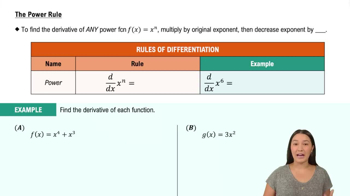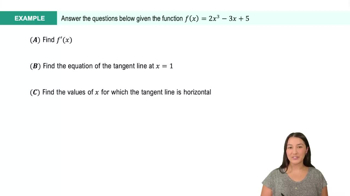Table of contents
- 0. Functions7h 52m
- Introduction to Functions16m
- Piecewise Functions10m
- Properties of Functions9m
- Common Functions1h 8m
- Transformations5m
- Combining Functions27m
- Exponent rules32m
- Exponential Functions28m
- Logarithmic Functions24m
- Properties of Logarithms34m
- Exponential & Logarithmic Equations35m
- Introduction to Trigonometric Functions38m
- Graphs of Trigonometric Functions44m
- Trigonometric Identities47m
- Inverse Trigonometric Functions48m
- 1. Limits and Continuity2h 2m
- 2. Intro to Derivatives1h 33m
- 3. Techniques of Differentiation3h 18m
- 4. Applications of Derivatives2h 38m
- 5. Graphical Applications of Derivatives6h 2m
- 6. Derivatives of Inverse, Exponential, & Logarithmic Functions2h 37m
- 7. Antiderivatives & Indefinite Integrals1h 26m
- 8. Definite Integrals4h 44m
- 9. Graphical Applications of Integrals2h 27m
- 10. Physics Applications of Integrals 2h 22m
3. Techniques of Differentiation
Basic Rules of Differentiation
Problem 84a
Textbook Question
Use the given graphs of f and g to find each derivative. <IMAGE>
d/dx (5f(x)+3g(x)) |x=1
 Verified step by step guidance
Verified step by step guidance1
Step 1: Understand the problem. We need to find the derivative of the function h(x) = 5f(x) + 3g(x) at x = 1, where f and g are functions whose graphs are provided.
Step 2: Apply the linearity of differentiation. The derivative of a sum of functions is the sum of their derivatives. Therefore, d/dx [5f(x) + 3g(x)] = 5 * d/dx [f(x)] + 3 * d/dx [g(x)].
Step 3: Evaluate the derivatives of f and g at x = 1. From the graphs, determine the slopes of the tangent lines to f(x) and g(x) at x = 1, which represent f'(1) and g'(1) respectively.
Step 4: Substitute the values of f'(1) and g'(1) into the expression from Step 2. This gives us 5 * f'(1) + 3 * g'(1).
Step 5: Calculate the final expression using the values obtained from the graphs. This will give the value of the derivative of h(x) at x = 1.
 Verified video answer for a similar problem:
Verified video answer for a similar problem:This video solution was recommended by our tutors as helpful for the problem above
Video duration:
5mPlay a video:
Was this helpful?
Key Concepts
Here are the essential concepts you must grasp in order to answer the question correctly.
Derivative
The derivative of a function measures how the function's output value changes as its input value changes. It is defined as the limit of the average rate of change of the function over an interval as the interval approaches zero. In practical terms, the derivative provides the slope of the tangent line to the graph of the function at a given point.
Recommended video:

Derivatives
Sum Rule of Derivatives
The sum rule states that the derivative of the sum of two functions is equal to the sum of their derivatives. Mathematically, if f(x) and g(x) are differentiable functions, then d/dx [f(x) + g(x)] = f'(x) + g'(x). This rule simplifies the process of finding derivatives when dealing with expressions that involve the addition of multiple functions.
Recommended video:

Algebra Rules for Finite Sums
Constant Multiple Rule
The constant multiple rule states that the derivative of a constant multiplied by a function is equal to the constant multiplied by the derivative of the function. Formally, if c is a constant and f(x) is a differentiable function, then d/dx [c * f(x)] = c * f'(x). This rule is essential for differentiating expressions where functions are scaled by constants.
Recommended video:

The Power Rule

 3:59m
3:59mWatch next
Master Derivatives of Linear Functions with a bite sized video explanation from Callie
Start learningRelated Videos
Related Practice






